Executive Summary
The broad-based appreciation of the euro this year raises some interesting macroeconomic questions. Specifically, will euro strength reduce export growth and thereby weigh on overall GDP growth? Will CPI inflation, which is benign already, recede further due to euro appreciation? In our view, we are still a long way away from worrying about the growth-restraining and CPIdepressing effects of euro appreciation, because the effects that the exchange rate has on export growth and CPI inflation tend to be rather modest.
Broad-Based Appreciation of the Euro in 2017
The euro has risen more than 5 percent on a trade-weighted basis this year (Figure 1). The euro has had a good run vis-à-vis the U.S. dollar, strengthening about 13 percent since the beginning of the year (Figure 2). But the euro’s strength has been broad based, with the common currency up about 8 percent against both the Japanese yen and the Swiss franc and roughly 3 percent versus the British pound. A detailed explanation for the euro’s appreciation is beyond the scope of this report. That said, stronger-than-expected economic data, which have prompted expectations of less accommodative ECB monetary policy going forward, undoubtedly have contributed to the rise in the value of the euro.
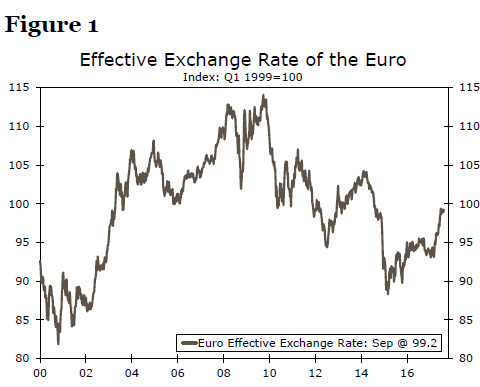
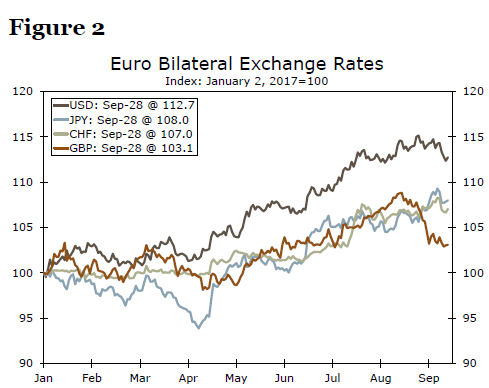
The focus of this report is to consider what macroeconomic effects, if any, the appreciation of the euro may have on the Eurozone.1 Will euro strength reduce export growth and thereby weigh on overall GDP growth? Will CPI inflation, which is benign already, recede further? Will the ECB, which appears poised to remove policy accommodation going forward, need to keep its quantitative easing (QE) program in place?
Exports More Sensitive to Foreign Growth than to Exchange Rate
In theory, exchange rate changes should have a meaningful effect on real GDP growth in the Eurozone as real exports of goods and services are equivalent to nearly 50 percent of real GDP in the euro area. However, these figures, which are derived from the Eurozone’s GDP accounts, include trade among the 19 individual economies in the Eurozone. Because countries in the euro area share a common currency, the trade flows between these individual economies are not affected directly by exchange rate changes. Exports among the 19 individual economies of the Eurozone account for 45 percent of total exports in the euro area.2 Consequently, exports to countries that are outside the euro area, which would potentially be sensitive to exchange rate changes, are equivalent to roughly one-quarter of GDP in the euro area, not one-half as referenced previously.
How sensitive are these exports to non-Eurozone countries to changes in the exchange value of the euro? Figure 3 shows that there is some correlation between year-over-year changes in the real effective value of the euro and year-over-year growth in real exports to non-Eurozone countries. That is, depreciation of the real effective exchange rate (i.e., the inflation adjusted, trade-weighted value of the euro) tends to be associated with stronger export growth and vice versa. That said, the degree of correlation between these two variables is rather low.
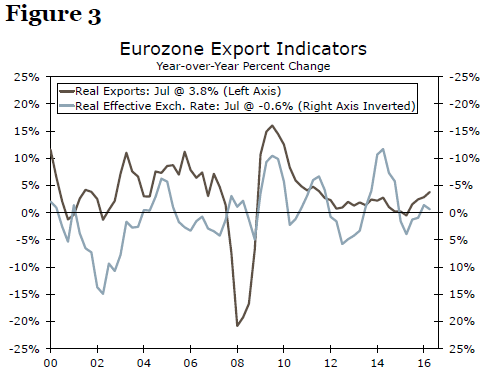
However, there is a high degree of correlation between growth in real exports to non-Eurozone economies and growth in global industrial production (Figure 4). The formal statistical analysis that we conducted—details are available upon request—shows that the relationship between changes in the real exchange rate and growth in real exports are statistically significant. However, real export growth is much more sensitive to changes to global IP than it is to changes in the real exchange rate.3 Unless the recent appreciation of the euro turns into a runaway train, which we do not expect, then positive economic growth in the rest of the world, which we do anticipate, should ensure that export growth in the euro area remains positive. In short, the recent appreciation of the euro may reduce Eurozone export growth by a few tenths of a percentage point, but it is not likely to cause export growth to nosedive.
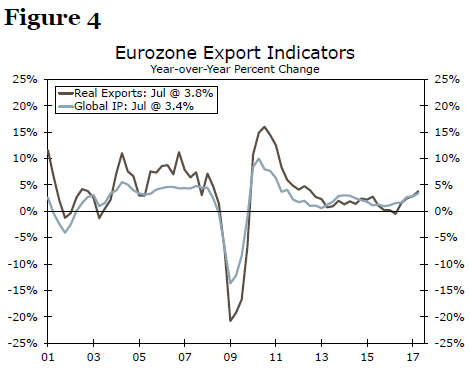
Services Mute Effect of Exchange Rate on Inflation
Everything else equal, euro appreciation puts downward pressure on import prices. If the amount of imports into the Eurozone is large enough, then lower import prices could cause consumer price inflation, which has been benign over the past few years, to recede further.4 In that regard, nominal imports currently are equivalent to 43 percent of nominal GDP in the euro area, suggesting that exchange rate appreciation could potentially lead to lower CPI inflation.
As in the case of exports, however, most individual economies in the Eurozone receive a significant amount of imports from other countries in the euro area, and these intra-Eurozone imports are not affected directly by exchange rate changes. Because Eurozone countries on average receive only half of their imports from countries that are outside the euro area, the relevant imports-to-GDP ratio for the overall Eurozone is about 20 percent or so.
There tends to be a fair degree of correlation between changes in the trade-weighted value of the euro and changes in non-oil import prices in Germany (Figure 5).5 However, changes in import prices do not appear to have much effect on both the overall and the core rate of CPI inflation in the euro area (Figure 6). Prices of services account for 45 percent of the Eurozone’s consumer price index, and services tend not to be as widely imported as goods. Consequently, the euro appreciation that has occurred to date is not likely to have a marked effect on CPI inflation in the Eurozone. The euro would need to strengthen significantly further for it to have a meaningful effect on CPI inflation in the Eurozone.
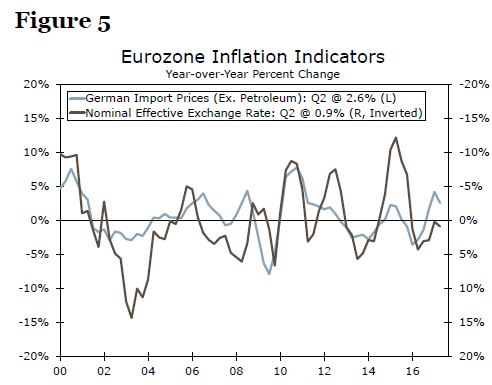
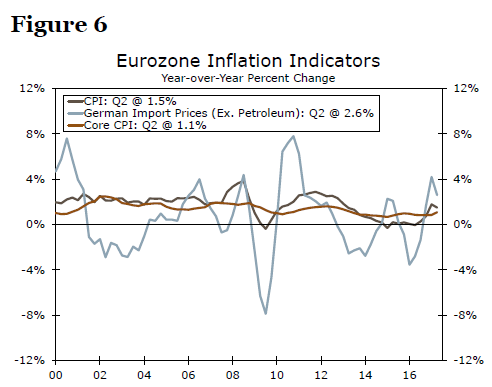
Conclusion
After trending lower between 2010 and 2015, the trade-weighted value of the euro reversed course in 2016 and has risen noticeably this year. Furthermore, our currency strategy team looks for further modest gains in the euro vis-à-vis the U.S. dollar and many other major currencies going forward. In theory, euro appreciation could weigh on real GDP growth in the Eurozone if it leads to slower growth in real exports of goods and services in the euro area. It could also depress consumer price inflation even further if it causes import prices to level out and potentially decline.
In our view, we are still a long way away from worrying about the growth-restraining and CPI-depressing effects of euro appreciation. For starters, the common currency that is shared by the 19 member countries of the euro area means that there is a significant amount of trade in the Eurozone that is not affected by exchange rate changes. Moreover, the effects that the exchange rate has on export growth and CPI inflation tend to be rather modest. Yes, real appreciation in the euro exchange rate is associated with slower export growth in the Eurozone, everything else equal. But the effects of economic growth in the rest of the world are significantly more important for real export growth than is the real exchange rate. As long as the global economy continues to expand at a healthy pace, which we expect, then real export growth in the euro area likely will remain positive.
Similarly, the effects of the exchange rate on CPI inflation tend to be rather small as well. Changes in the nominal effective exchange rate can change import prices in the opposite direction (i.e., declines in the exchange rate are associated with increases in import prices and vice versa), but the effects on import price inflation are not one-for-one. Furthermore, services comprise one-half of the consumer price index, and services tend not to be imported to the same extent as are goods. Euro appreciation could eventually shave off a few tenths of a percentage point off of CPI inflation in the Eurozone. However, as long as the economic expansion in the euro area remains healthy, which we expect, inflation should slowly trend higher over time. Consequently, we look for the ECB to dial back its bond purchases further in coming months and for it to commence a slow pace of rate hikes in late 2018.













